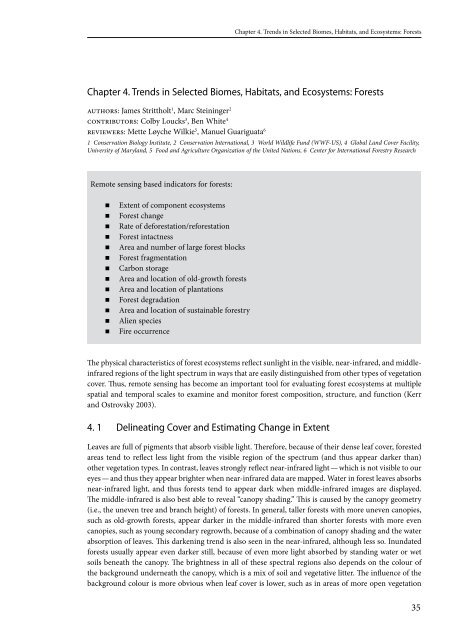SourCeBook oN remoTe SeNSiNg aND BioDiverSiTy iNDiCaTorS
SourCeBook oN remoTe SeNSiNg aND BioDiverSiTy iNDiCaTorS
SourCeBook oN remoTe SeNSiNg aND BioDiverSiTy iNDiCaTorS
Create successful ePaper yourself
Turn your PDF publications into a flip-book with our unique Google optimized e-Paper software.
Chapter 4. Trends in Selected Biomes, Habitats, and Ecosystems: Forests<br />
Chapter 4. Trends in Selected Biomes, Habitats, and ecosystems: Forests<br />
Authors: James Strittholt 1 , Marc Steininger<br />
Contributors: Colby Loucks 3 , Ben White 4<br />
Reviewers: Mette Løyche Wilkie 5 , Manuel Guariguata 6<br />
1 Conservation Biology Institute, 2 Conservation International, 3 World Wildlife Fund (WWF-US), 4 Global Land Cover Facility,<br />
University of Maryland, 5 Food and Agriculture Organization of the United Nations, 6 Center for International Forestry Research<br />
Remote sensing based indicators for forests:<br />
�<br />
�<br />
�<br />
�<br />
�<br />
�<br />
�<br />
�<br />
�<br />
�<br />
�<br />
�<br />
�<br />
Extent of component ecosystems<br />
Forest change<br />
Rate of deforestation/reforestation<br />
Forest intactness<br />
Area and number of large forest blocks<br />
Forest fragmentation<br />
Carbon storage<br />
Area and location of old-growth forests<br />
Area and location of plantations<br />
Forest degradation<br />
Area and location of sustainable forestry<br />
Alien species<br />
Fire occurrence<br />
The physical characteristics of forest ecosystems reflect sunlight in the visible, near-infrared, and middleinfrared<br />
regions of the light spectrum in ways that are easily distinguished from other types of vegetation<br />
cover. Thus, remote sensing has become an important tool for evaluating forest ecosystems at multiple<br />
spatial and temporal scales to examine and monitor forest composition, structure, and function (Kerr<br />
and Ostrovsky 003).<br />
4. 1 Delineating Cover and estimating Change in extent<br />
Leaves are full of pigments that absorb visible light. Therefore, because of their dense leaf cover, forested<br />
areas tend to reflect less light from the visible region of the spectrum (and thus appear darker than)<br />
other vegetation types. In contrast, leaves strongly reflect near-infrared light — which is not visible to our<br />
eyes — and thus they appear brighter when near-infrared data are mapped. Water in forest leaves absorbs<br />
near-infrared light, and thus forests tend to appear dark when middle-infrared images are displayed.<br />
The middle-infrared is also best able to reveal “canopy shading.” This is caused by the canopy geometry<br />
(i.e., the uneven tree and branch height) of forests. In general, taller forests with more uneven canopies,<br />
such as old-growth forests, appear darker in the middle-infrared than shorter forests with more even<br />
canopies, such as young secondary regrowth, because of a combination of canopy shading and the water<br />
absorption of leaves. This darkening trend is also seen in the near-infrared, although less so. Inundated<br />
forests usually appear even darker still, because of even more light absorbed by standing water or wet<br />
soils beneath the canopy. The brightness in all of these spectral regions also depends on the colour of<br />
the background underneath the canopy, which is a mix of soil and vegetative litter. The influence of the<br />
background colour is more obvious when leaf cover is lower, such as in areas of more open vegetation<br />
35


